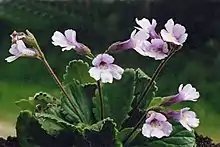Haberlea
Haberlea is a monotypic genus[2] of flowering plants in the family Gesneriaceae. The only member of this genus, Haberlea rhodopensis, is endemic to parts of Bulgaria and a small part of northern Greece, especially in the Rhodope Mountains.[3] Common names include Orpheus flower and resurrection plant because of the remarkable ability of Haberlea to survive very long periods of desiccation.[4]
| Haberlea | |
|---|---|
 | |
| Haberlea rhodopensis | |
| Scientific classification | |
| Kingdom: | Plantae |
| Clade: | Tracheophytes |
| Clade: | Angiosperms |
| Clade: | Eudicots |
| Clade: | Asterids |
| Order: | Lamiales |
| Family: | Gesneriaceae |
| Subfamily: | Cyrtandroideae |
| Tribe: | Didymocarpeae |
| Genus: | Haberlea Friv. |
| Species: | H. rhodopensis |
| Binomial name | |
| Haberlea rhodopensis Friv.[1] | |
| Synonyms | |
|
Haberlea ferdinandi-coburgii[1] | |
The species is a stemless, evergreen perennial found in north-facing rocky habitats. Basal rosettes of dark green leaves bear trumpet-shaped flowers in shades of white, violet or purple in spring and summer.
Despite the zygomorphic nectar-producing flowers (which are considered an ancestral character) and the overall trend in Gesneriaceae, resurrection plant is only rarely pollinated by bees and does not have specific pollinators. Rather its evolution has switched in the direction of providing pollen as a reward and generalisation of pollinating insects - a trend that is observed in the other two European members (Jankaea and Ramonda) of the more tropically and subtropically spread family Gesneriaceae. Active pollinators of Haberlea are found to be syrphids (hoverflies) and Lasioglossum morio (Hymenoptera, Halictidae) which are characterised by low preferential behaviour regarding the plants that they visit for food.[5]
Haberlea rhodopensis (pale lilac flowers) has gained the Royal Horticultural Society's Award of Garden Merit.[6][7]
See also
References
- "Haberlea rhodopensis Friv.". World Checklist of Selected Plant Families (WCSP). Royal Botanic Gardens, Kew. Retrieved 10 August 2015 – via The Plant List.
- "Haberlea". The Plant List. Retrieved 10 August 2015.
- Bazos, I. & Petrova, A. (2011). "Haberlea rhodopensis". IUCN Red List of Threatened Species. 2011: e.T165162A5984626. doi:10.2305/IUCN.UK.2011-1.RLTS.T165162A5984626.en. Retrieved 14 January 2018.
- "Molecular mechanisms of desiccation tolerance in the resurrection glacial relic Haberlea rhodopensis".
- "Pollination Ecology of Haberlea rhodopensis Friv. (Gesneriaceae), A Tertiary Relict Endemic To The Balkan Peninsula".
- "Haberlea rhodopensis AGM". Retrieved 23 February 2020.
- "AGM Plants - Ornamental" (PDF). Royal Horticultural Society. July 2017. p. 43. Retrieved 3 March 2018.